ikfoundation.org
Promoting Natural & Cultural History
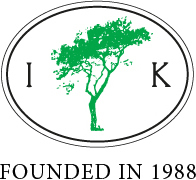


ESSAYS |
HANDICRAFT AND READING: 1770s to 1840s
– Home Interiors depicted by Swedish and Danish Artists
This picture essay in chronological order may be regarded as a random selection, but when examined more closely, these six well-to-do home interiors give a surprisingly exhaustive insight into the everyday lives of women, men and children alike. The other aims of this case study are to make observations of the impression each artist liked to bring about or how the portrayed wished to be immortalised. The portraiture of family members was carefully composed with the arrangement of suitable backdrops, elegant clothes at times with attributes of luxurious, up-to-date fashions, and the objective of visualising a comfortable standard of living. These artworks, made by Swedish and Danish artists around the time period 1772 to 1845, demonstrate industriousness in knitting, quilt making, sewing, spinning and educational needlecraft in contrast to more relaxed attitudes to hands-on skills and scientific learning on some artworks.
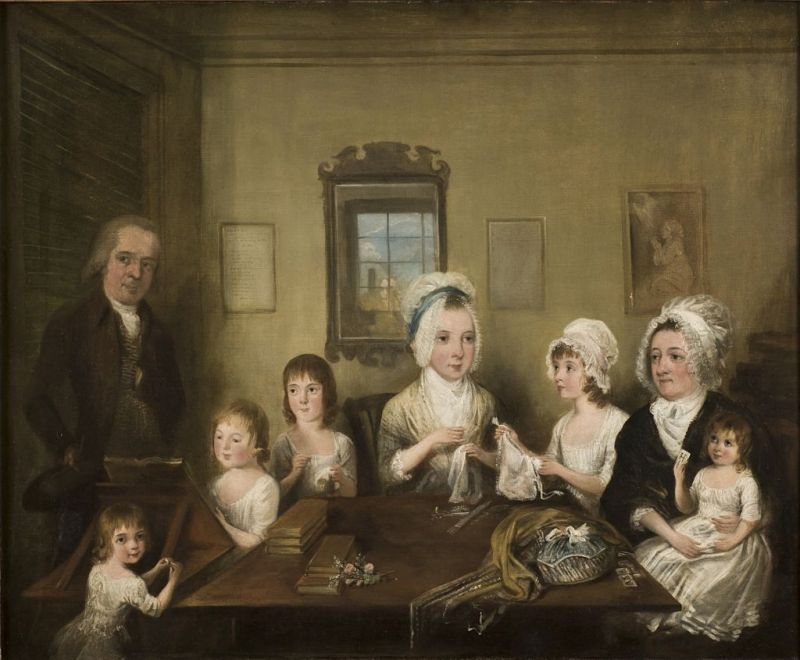 This inviting group portrait by the Swedish artist Elias Martin (1739-1818), shows the LaTrobe family and their textile handicraft with various sewing and embroidery projects together with the reading of books and even the smallest child holds an educational card with the letter H, whilst the father keeps a watching eye. To display an interest in book learning and handicraft was not unusual in paintings of the time and this particular family was portrayed by Elias Martin in the London area in the early 1770s. The Swedish artist stayed for more than 10 years in England after educational years in Le Havre, Paris and Rome – as well as being back in London in the years 1788 to 1791, after which returning to Stockholm where he came to stay for the rest of his life. Benjamin Bonneval LaTrobe (1728-1796), his wife Anna Margaretta LaTrobe (1728-1794), five of their six children and the nursemaid were all included in this informative picture. | Oil on canvas, named ‘Portrait of the Family LaTrobe of Fulneck’ in West Yorkshire, England. (Courtesy: National museum, Stockholm, Sweden. NM 6949. Wikimedia Commons).
This inviting group portrait by the Swedish artist Elias Martin (1739-1818), shows the LaTrobe family and their textile handicraft with various sewing and embroidery projects together with the reading of books and even the smallest child holds an educational card with the letter H, whilst the father keeps a watching eye. To display an interest in book learning and handicraft was not unusual in paintings of the time and this particular family was portrayed by Elias Martin in the London area in the early 1770s. The Swedish artist stayed for more than 10 years in England after educational years in Le Havre, Paris and Rome – as well as being back in London in the years 1788 to 1791, after which returning to Stockholm where he came to stay for the rest of his life. Benjamin Bonneval LaTrobe (1728-1796), his wife Anna Margaretta LaTrobe (1728-1794), five of their six children and the nursemaid were all included in this informative picture. | Oil on canvas, named ‘Portrait of the Family LaTrobe of Fulneck’ in West Yorkshire, England. (Courtesy: National museum, Stockholm, Sweden. NM 6949. Wikimedia Commons).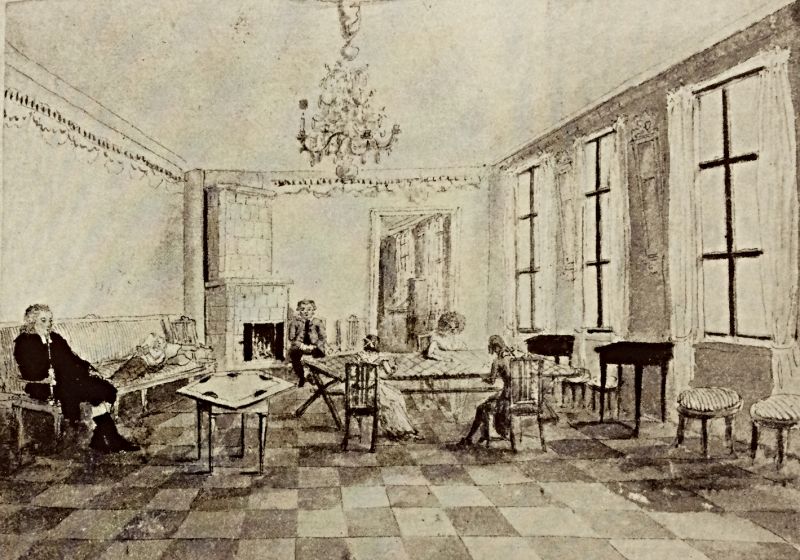 An enlightening watercolour by the artist Isak Kjölström (1769-1821), which illustrates the daily life at the parsonage Brunnby in Östergötland province, Sweden in the year 1797. Two female and one male individual (probably mother and two children) worked at the quilting frame, a popular handicraft at this time, to make multi-layered padded warm bedcovers of silk or cotton. In contrast to the actively ongoing textile work in this home interior, the priest himself was leaning back in a sofa besides a resting poorly child reading a book. Whilst a boy looked after the burning fire, sitting close to the tiled stove. The bright room has three large-sized windows with gauzy white floor-length cotton or linen curtains. Furthermore, Kjölström had studied at the Art Academy in Stockholm during his younger years for the famous artist Elias Martin (image above), which may be why these two household centred interiors has some resemblance. (Private Ownership, black and white version of watercolour).
An enlightening watercolour by the artist Isak Kjölström (1769-1821), which illustrates the daily life at the parsonage Brunnby in Östergötland province, Sweden in the year 1797. Two female and one male individual (probably mother and two children) worked at the quilting frame, a popular handicraft at this time, to make multi-layered padded warm bedcovers of silk or cotton. In contrast to the actively ongoing textile work in this home interior, the priest himself was leaning back in a sofa besides a resting poorly child reading a book. Whilst a boy looked after the burning fire, sitting close to the tiled stove. The bright room has three large-sized windows with gauzy white floor-length cotton or linen curtains. Furthermore, Kjölström had studied at the Art Academy in Stockholm during his younger years for the famous artist Elias Martin (image above), which may be why these two household centred interiors has some resemblance. (Private Ownership, black and white version of watercolour).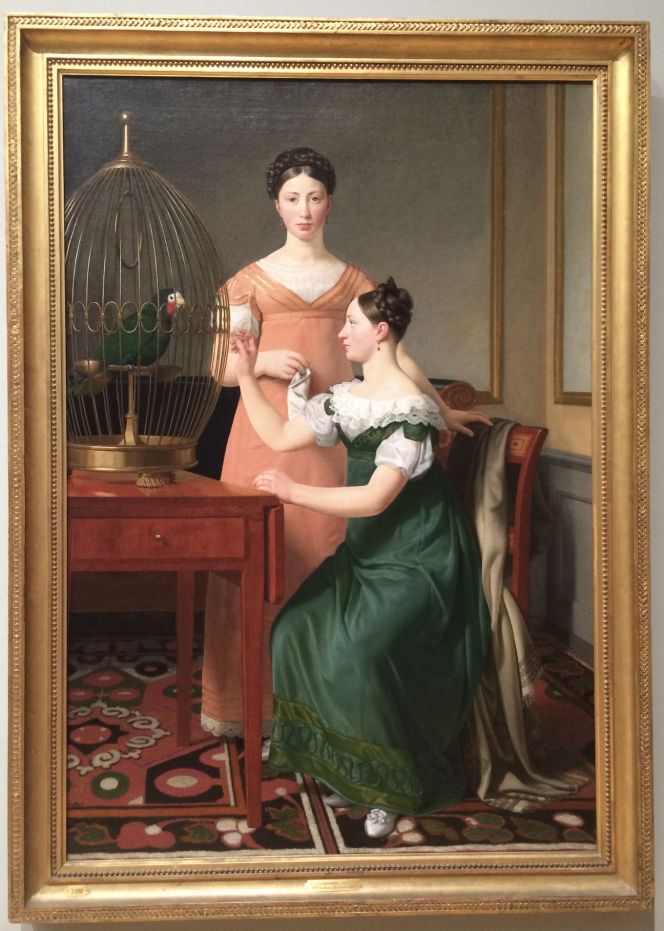 While this oil on canvas by the Danish artist Christoffer Wilhelm Eckersberg (1783-1853), representing ‘Mendel Levin Nathanson’s Elder Daughters, Bella and Hanna’ in 1820. Eckersberg was regarded as the master of portraits among other genres and also seen as the artist who introduced the period in art known as the Danish Golden Age. To portray siblings, draped or folded textiles, small-sized knitting projects, distraction or concentration as well as a melancholic impression in home interiors were common in the Romantic Era. This painting includes all these features. The handicraft is visible via the standing girl’s ongoing knitting of a white silk or cotton sock, simultaneously as the choice of matching colours was intended to be the main focus – the high standard of living was visualised as stylish and perfect. Their colourful clothing either stand out from the background or harmonised with other depicted objects – particularly striking is the carefully chosen intense green colour of the dress, the caged parrot as well as on leaf work on the ornamented woollen carpet. (Collection: Statens Museum for Kunst, København, Denmark. No: KMS3498. On display in 2019). Photo: Viveka Hansen, The IK Foundation.
While this oil on canvas by the Danish artist Christoffer Wilhelm Eckersberg (1783-1853), representing ‘Mendel Levin Nathanson’s Elder Daughters, Bella and Hanna’ in 1820. Eckersberg was regarded as the master of portraits among other genres and also seen as the artist who introduced the period in art known as the Danish Golden Age. To portray siblings, draped or folded textiles, small-sized knitting projects, distraction or concentration as well as a melancholic impression in home interiors were common in the Romantic Era. This painting includes all these features. The handicraft is visible via the standing girl’s ongoing knitting of a white silk or cotton sock, simultaneously as the choice of matching colours was intended to be the main focus – the high standard of living was visualised as stylish and perfect. Their colourful clothing either stand out from the background or harmonised with other depicted objects – particularly striking is the carefully chosen intense green colour of the dress, the caged parrot as well as on leaf work on the ornamented woollen carpet. (Collection: Statens Museum for Kunst, København, Denmark. No: KMS3498. On display in 2019). Photo: Viveka Hansen, The IK Foundation.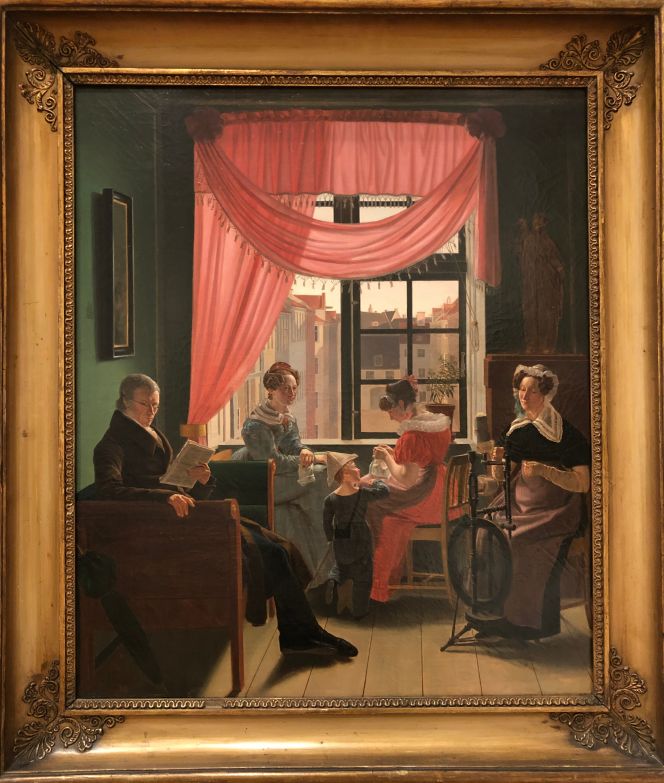 Portrait of a bourgeoise Copenhagen family in 1828, painted by the Danish artist Emilius Bærentzen (1799-1868), who had been one of Christoffer Wilhelm Eckersberg’s students – the master painter discussed above – at the Danish Academy in the early 1820s. Noticeable in this tranquil and melancholy home interior depiction is that it demonstrates traditional family values in the form of various ongoing female handicraft, a young son playing calmly in his paper tricorn hat and a father who reads a newspaper. Especially informative details of textile work, visualise that the mother (or maybe a daughter) wears an apron for protection of her black silk or cotton dress when spinning wool on the spinning-wheel. Whilst, two daughters are seated close to the open window to get the best possible daylight for sewing and knitting. The curtain arrangement – draped and tied back to one side – gives a pleasant light for the room and further gives an impression of the peaceful everyday atmosphere of the apartment. (Collection: Statens Museum for Kunst, København, Denmark. No: KMS8588. On display in 2021). Photo: Viveka Hansen, The IK Foundation.
Portrait of a bourgeoise Copenhagen family in 1828, painted by the Danish artist Emilius Bærentzen (1799-1868), who had been one of Christoffer Wilhelm Eckersberg’s students – the master painter discussed above – at the Danish Academy in the early 1820s. Noticeable in this tranquil and melancholy home interior depiction is that it demonstrates traditional family values in the form of various ongoing female handicraft, a young son playing calmly in his paper tricorn hat and a father who reads a newspaper. Especially informative details of textile work, visualise that the mother (or maybe a daughter) wears an apron for protection of her black silk or cotton dress when spinning wool on the spinning-wheel. Whilst, two daughters are seated close to the open window to get the best possible daylight for sewing and knitting. The curtain arrangement – draped and tied back to one side – gives a pleasant light for the room and further gives an impression of the peaceful everyday atmosphere of the apartment. (Collection: Statens Museum for Kunst, København, Denmark. No: KMS8588. On display in 2021). Photo: Viveka Hansen, The IK Foundation.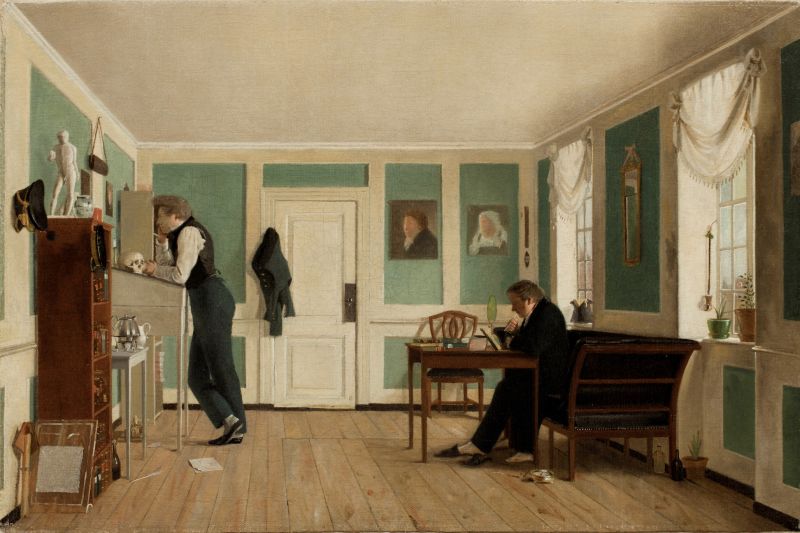 Men were often depicted as studious and well suited for scientific knowledge however, which in this painstakingly detailed painting from circa 1829 is emphasised with; a statue, artistic sketchbooks, bookshelves, writing desks, a human skull, a botanical tin for collecting outdoors, pieces of notes scattered on the floor etc. At the same time as the sparsely furnished room itself reveals a calm atmosphere, suitable for thinking and working. The knowledge of time and place – an interior from Amaliegade in København (Copenhagen) in the artist’s and his brother’s apartment – gives further insight into this oil on canvas by the young Danish artist Wilhelm Bendz (1804-1832). The at home feeling was further drawn attention to via the two men’s everyday plain dark coloured garments, indoor shoes and white tall-collared shirts of the time. (Collection: Den Hirschsprungske Samling, København, Denmark. No. 31. On display in 2019). Photo: Viveka Hansen, The IK Foundation.
Men were often depicted as studious and well suited for scientific knowledge however, which in this painstakingly detailed painting from circa 1829 is emphasised with; a statue, artistic sketchbooks, bookshelves, writing desks, a human skull, a botanical tin for collecting outdoors, pieces of notes scattered on the floor etc. At the same time as the sparsely furnished room itself reveals a calm atmosphere, suitable for thinking and working. The knowledge of time and place – an interior from Amaliegade in København (Copenhagen) in the artist’s and his brother’s apartment – gives further insight into this oil on canvas by the young Danish artist Wilhelm Bendz (1804-1832). The at home feeling was further drawn attention to via the two men’s everyday plain dark coloured garments, indoor shoes and white tall-collared shirts of the time. (Collection: Den Hirschsprungske Samling, København, Denmark. No. 31. On display in 2019). Photo: Viveka Hansen, The IK Foundation.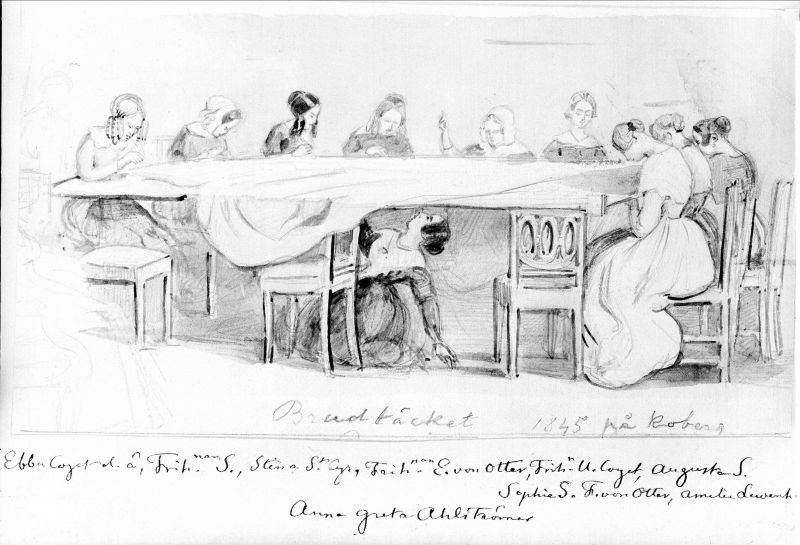 A concluding picture, illustrates ’The Wedding bedcover in 1845” at the Koberg manor house in Västergötland province, Sweden. This is a fascinating documentation of women’s textile collective work in an elite environment, a theme which seems to have engaged the artist Fritz von Dardel (1817-1901) over and over again, evident via several extant drawings of women attentively bent over their stitching and knitting in well-to-do Swedish homes. To stitch wadded layered bedcovers of silk and cotton prior to a young girl’s wedding in affluent families – to be used for warmth as well as a beautiful display – is evident already in written sources from the previous century. One such origin is via Märta Helena Reenstierna’s (1753-1841) Årsta Diary (Årstadagboken) as she wrote at her home Årsta manor house, close to Stockholm during a forty year period. On 24 May in 1799 for instance, she admired an embroidery made by a lady in her circle of friends: ‘I also saw one of Mrs Vestman’s rose-red silk serge bedcovers, which was sent and very finely stitched – for a wedding bedcover.’ Interestingly, the ten young women who stitched this bedcover in 1845 was not only illustrated with their individual fashionable dresses and hairstyles, but also with each and everyone’s name included on the drawing. To my knowledge, this is also the only artwork from this period, which demonstrate that such a large number of individuals were involved in the stitching of one wedding bedcover. (Courtesy: The Nordic Museum, Stockholm, Sweden. NMA.0036354. Digitalt Museum).
A concluding picture, illustrates ’The Wedding bedcover in 1845” at the Koberg manor house in Västergötland province, Sweden. This is a fascinating documentation of women’s textile collective work in an elite environment, a theme which seems to have engaged the artist Fritz von Dardel (1817-1901) over and over again, evident via several extant drawings of women attentively bent over their stitching and knitting in well-to-do Swedish homes. To stitch wadded layered bedcovers of silk and cotton prior to a young girl’s wedding in affluent families – to be used for warmth as well as a beautiful display – is evident already in written sources from the previous century. One such origin is via Märta Helena Reenstierna’s (1753-1841) Årsta Diary (Årstadagboken) as she wrote at her home Årsta manor house, close to Stockholm during a forty year period. On 24 May in 1799 for instance, she admired an embroidery made by a lady in her circle of friends: ‘I also saw one of Mrs Vestman’s rose-red silk serge bedcovers, which was sent and very finely stitched – for a wedding bedcover.’ Interestingly, the ten young women who stitched this bedcover in 1845 was not only illustrated with their individual fashionable dresses and hairstyles, but also with each and everyone’s name included on the drawing. To my knowledge, this is also the only artwork from this period, which demonstrate that such a large number of individuals were involved in the stitching of one wedding bedcover. (Courtesy: The Nordic Museum, Stockholm, Sweden. NMA.0036354. Digitalt Museum).Sources:
- Ashelford, Jane, The Art of Dress: Clothes and Society 1500-1914, London 2002.
- Den Hirschsprungske Samling (The Hirschsprung Collection), København, Denmark. | Visit the exhibitions in 2019.
- Den Hirschsprungske Samling, Fra den bedste side: Portræt og følsomhed i guldalderen, København 2018.
- Nordisk Familjebok, Stockholm 1912 (Encyclopedia, Vol. 17. ‘Martin, Elias’, pp. 1110-1111).
- Reenstierna, Märta Helena, Årstadagboken: journaler från åren 1793-1839, del 1-3, ed. Gunnar Broman and Sigurd Erixon, Stockholm 1985.
- Statens Museum for Kunst (National Gallery Denmark), København, Denmark. | Visits at the exhibitions in 2019 and 2021.
- The Nordic Museum, Stockholm, Sweden. (Digitalt Museum, search words: Fritz von Dardel).
Essays
The iTEXTILIS is a division of The IK Workshop Society - a global and unique forum for all those interested in Natural & Cultural History from a Textile Perspective.
Open Access essays - under a Creative Commons license and free for everyone to read - by Textile historian Viveka Hansen aiming to combine her current research and printed monographs with previous projects dating back to the late 1980s. Some essays also include unique archive material originally published in other languages, made available for the first time in English, opening up historical studies previously little known outside the north European countries. Together with other branches of her work; considering textile trade, material culture, cloth manufacturing, fashion, natural dyeing and the fascinating world of early travelling naturalists – like the "Linnaean network" – from a Global history perspective.
For regular updates, and to make full use of iTEXTILIS' possibilities, we recommend fellowship by subscribing to our monthly newsletter iMESSENGER.
been copied to your clipboard




– a truly European organisation since 1988
Legal issues | Forget me | and much more...
It is free to use the information/knowledge in The IK Workshop Society so long as you follow a few rules.
 LEARN MORE
LEARN MORE








